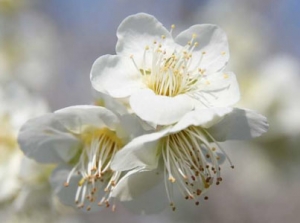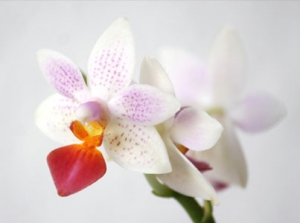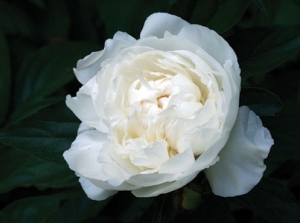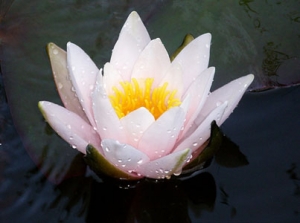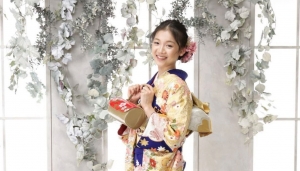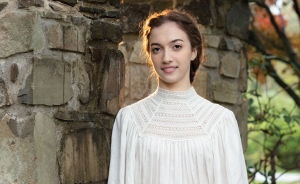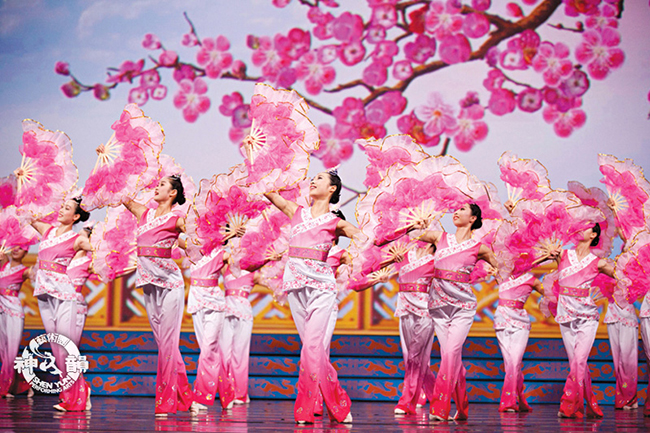
Ziedlapiņu spēks
Gadu gaitā Shen Yun izrādes ir izvedušas mūs un skatītājus cauri bezgalīgiem Ķīnas civilizācijas skatiem. Taču ārpus seniem pils pagalmiem un Debesu valstībām mūsu izrādēs dažkārt ir arī kāda vienkārša tēma: ziedi.
Senajā Ķīnā ziedu valodai bija dziļa nozīme, un ziedi parādījās kā motīvs mākslas darbos, literatūrā un valodā. Neskatoties uz to izplatību, katra zieda nozīme ir dziļa un joprojām ļoti cienīta ķīniešu kultūras sastāvdaļa. Lūk dažas, kuras pēdējos gados ir parādījušās uz Shen Yun skatuves:
Plūmes zieds
Pieticīgo plūmes ziedu ar tās maigi rozā ziedlapiņām var viegli sajaukt ar tās brālēnu, ķiršu ziedu, kas zied pavasarī. Taču plūmes zieds uzzied ziemas vidū. Spilgti un izturīgi ziedi sala un sniega apstākļos ir iedvesmojošs skats, kas simbolizē neatlaidību un drosmi, saskaroties ar grūtībām.
Mākslā plūmes ziedi bieži tiek attēloti kopā ar citiem ziemas draugiem – priedi un bambusu, lai attēlotu tādas vērtības kā apņēmība, godīgums un pieticība. Vairāk par visu šie plūmju ziedi simbolizē cerību un solījumu, ka pavasaris patiešām ir tepat aiz stūra.
Peonija
Peonijas bagātīgie un greznie ziedi jau izsenis ir padarījuši to par ziedu valstības valdnieci. Lai gan sākotnēji zieds tika kultivēts tā ārstniecisko īpašību dēļ, Suju un Tanu dinastijas pārstāvji iekļāva šo ziedu imperatora dārzos tā neparastā skaistuma dēļ. Sunu dinastijas laikā peoniju audzēšana izplatījās visā valstī, un zieds kļuva par dzīvu dižciltības un nevainojamas elegances simbolu. Pazīstama arī kā "bagātības un goda zieds" un "ziedu karalis", peonija smaržo tikpat saldi kā jebkurā citā vārdā nosaukta.
Lotoss
Ķīniešu valodā vārds lotoss ir homonīms vārdam harmonija jeb viņš. Lotoss paceļas no duļķainiem ūdeņiem, lai krāšņi uzziedētu. Budisma izplatība Ķīnā radīja mākslas darbus, kuros attēloti Budas un Bodhisatvas, kas sēž uz lotosa ziediem, tādējādi izceļot zieda neaptraipīto dabu. Tāpēc lotoss ir tīras sirds un labvēlības simbols. Tie klusi zied starp zaļām lapām un klusiem ūdeņiem, atspoguļo mierīgu, ēterisku skaistumu, kas pārsniedz parastās dzīves robežas.
Orhideja
Lai gan Shen Yun izrādēs nav deju, kuras būtu īpaši veltītas orhidejām, šis zieds parādās daudzās Shen Yun dejās. Viena no svarīgākajām roku pamatpozīcijām dejotājām klasiskajā ķīniešu dejā ir laņ hua džan jeb “orhidejas roka”. Šo žestu veido, saliekot vidējo pirkstu un īkšķi pie pirkstu locītavas pamatnes tā, lai tie satiktos plaukstas centrā. Neatkarīgi no tā, vai šī rokas pozīcija tiek izmantota, lai attēlotu elegantu jaunu meiteni, vai Debesu feju, ķīniešu klasiskajā dejā laņ hua džan ir augstākā forma sievišķīgās elegances izpausmei.
Ārpus skatuves, ķīniešu filozofs Konfūcijs salīdzina orhideju ar tikumīgu kungu. Kādā grūtā dienā sarūgtinātais Konfūcijs mežā nejauši ieraudzīja orhideju, un, lai gan neviens to neredzēja, tā joprojām ziedēja un maigi smaržoja. Orhidejas viņam atgādināja, ka dižciltīgie turas pie tā, kam viņi tic, neatkarīgi no tā, ko domā citi.
***
Ķīniešu kultūrā puķes ir mirdzošas visās to izpausmēs, tās ir skaistuma un morāles, vienotības un drosmes, tīrības un cerības paraugi, kas bagātina seno ķīniešu sabiedrību gan no iekšēji, gan no ārpuses.

Džeida Džaņa
Līdzautore
May 8, 2013


